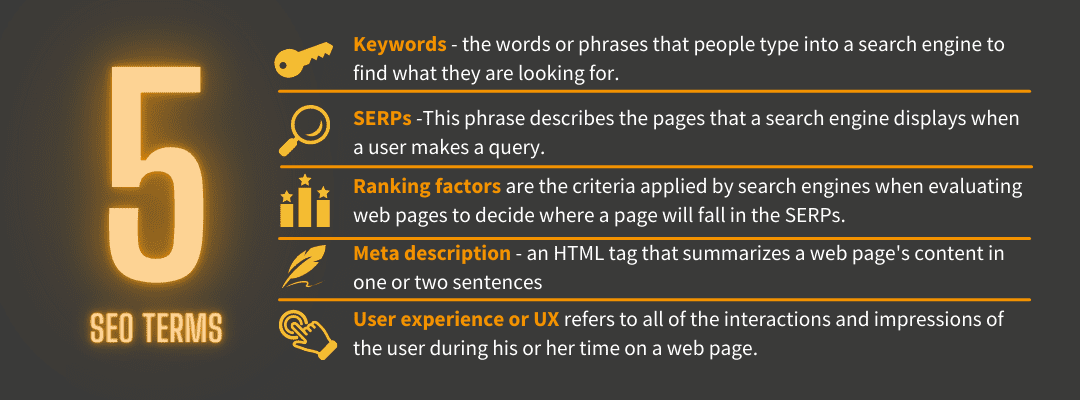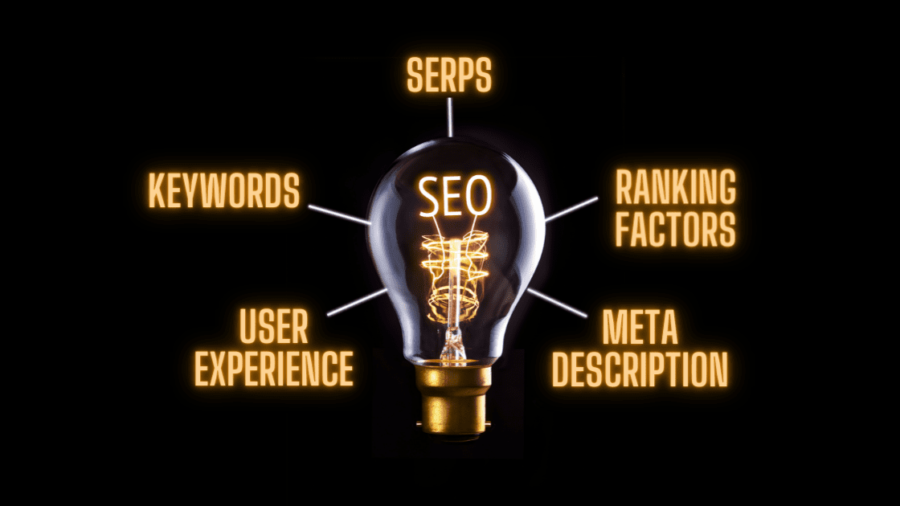Last Updated March 21, 2023 ago | Published: September 23, 2021
Let’s face it; Search Engine Optimization has a language all its own, made up of a long list of SEO terms. But by understanding and using these terms effectively, businesses can optimize their content to connect with potential clients and customers.
So how can you unlock this unique vocabulary and start effectively communicating with clients? Instead of focusing on the words themselves, the meanings, and the power of the tools and practices. In this mini-SEO glossary, we’ll look closely at five essential SEO terms for a successful content strategy.
1. Keywords. They’re at the heart of queries.
What are keywords, and why are they so important? Keywords are the words or phrases that people use or type into a search engine to find what they are looking for. If a website wants users searching for a particular target keyword to discover it, it needs to include the word or phrase in specific locations of the content. Some examples of where to place them are: early in the text, the meta description, the page title and headings, and any alt text.
Keywords are essential to SEO because they signal to search engines that the content will address a searcher’s question. Content marketers employ a variation called a long-tail keyword. These are phrases people use when searching for specific information. Long-tail keywords have lower search volume, but the searchers using them tend to be more intent on taking action based on the search results.
Content marketing managers, editors, and writers strive to create keyword-rich content that will be relevant in search engine algorithms. They must not overdo it, however.
A blog post that uses keywords too frequently might be flagged as keyword stuffing or spamming and can result in punishment by Google or lower rankings in Google SERPs. This is an example of black hat SEO. There is an artful strategy to using vital keywords and working them into your content.
Thorough keyword research will turn up a focus keyword (possibly a long-tail keyword), keyword phrases, keyword questions, and a list of must-have keywords. Using platforms and services such as rellify helps a business post SEO-friendly content that will rank high in organic search results to build the best content relevance strategy.
2. SERPs. Landing your SEO terms at the top of the charts.
Why is SERP, or Search Engine Results Page, a key term for better SEO and content ranking? This phrase describes the pages that a search engine displays when a user makes a query.
Frequently, the first few results will be pay-per-click ads.
Google also might display SERP features, which are the search engine’s attempt to answer the query before the searcher clicks into a web page. Common features are:
- Knowledge cards. A box that answers a simple question, such as “Who won the Super Bowl in 1979?”
- Featured snippets. An excerpt from one of the top organic results succinctly answers a query.
- Shopping results. A roundup of paid ads.
- People also asked. A list of questions related to the query with organic links to answers.
The organic results of SERPs list the web pages that the search engine has deemed most relevant to the query. SEO marketers strive to be one of the first three organic results. About 75 percent of all clicks go to the top three results. Web pages that appear on the second page or beyond receive relatively few clicks if any.
That’s why relevance is so important in creating content.
3. Ranking factors. How the winners are chosen.
Ranking factors are the criteria applied by search engines when evaluating web pages to decide where a page will fall in the SERPs. Ranking factors can include a website’s content, backlinks, user signals, technical implementation, mobile-friendliness, social media links, and more.
As you can see, a lot of essential elements go into ranking factors. Before you get overwhelmed, make sure to look into each component and see if your business is appropriately utilizing each one. Or, if you already have each of these factors, look deeper into the analytics of how they may be affecting your search rankings and if they may need a refresh.
One of the best things you can focus on with your content strategy is having relevant content that helps answer searchers’ questions and stands the test of time. Also, keep in mind that Google and other search engines are constantly updating their algorithms, which affects the ranking factors. This is why it is good to stay in tune with future-facing tools to help your website reach potential customers best.

4. Meta description. Indirect importance.
A meta description is an HTML tag that summarizes a web page’s content in one or two sentences — about the length of a tweet. It usually appears on SERPs along with the URL and the title.
A well-crafted meta description can improve the chances that someone will click on the link to your web page instead of some other website when that page pops up after a query is made. So, even though it is not a direct ranking factor, these snippets should be written with care and purpose. The proper use of such HTML tools, including anchor text, title tags, adds to the crawlability of a site.
A content marketer can improve the click-through rate by writing a meta description that:
- Includes keywords
- Uses active, engaging language.
- Emphasizes the relevance of the content.
A good meta description can drive the click-through rate, which could, in turn, lead the search engine to boost your site’s ranking, domain authority, and E-A-T.
5. User experience. Make it easy?
The last of our SEO terms, user experience, or UX, refers to users’ interactions and impressions during their time on a web page. This is an element of on-page SEO.
Website developers must keep this in mind because Google certainly does. Some crucial factors when creating a quality user experience are:
- Easy-to-read text
- Clear call to action buttons or designs
- High-quality images and graphics
- Quick loading speed
- Easy to navigate home web-page
- A mobile-first website
A website owner should dig deep into the thought processes of the browser or customer when considering what bells and whistles to include on a site.
A satisfying user experience can have long-term positive effects on the success of a website in search results. Essential signals that indicate a user experience are click-through rate, visit duration, and return-to-SERP rate.
You don’t want a clunky website to overshadow your great content. Instead, your great work should make the audience feel welcomed and comfortable.
Integrate more SEO terms into your strategy
We have reviewed five essential SEO terms, but optimization covers multitudes of terms and tactics. Some businesses find it overwhelming to keep up, yet they need to gain every benefit possible from their internet presence.
A company like rellify can help. It offers a content performance platform that can provide an end-to-end solution to digital content marketing.
And for more information on SEO basics, Artificial Intelligence, Machine Learning, and related topics, visit rellify’s glossary.
